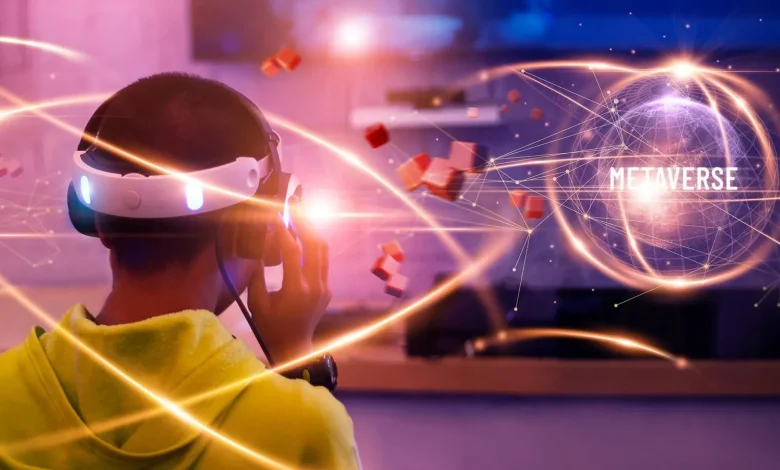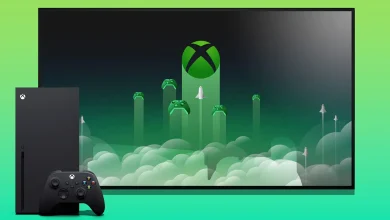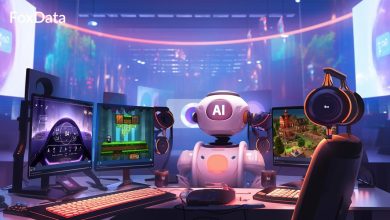Exploring the Latest Gaming Technology Trends: Shaping the Future of Interactive Entertainment
Shaping the Future of Interactive Entertainment

Introduction:
The gaming industry is in a constant state of evolution, driven by rapid advancements in technology and innovation. From cutting-edge hardware to revolutionary software developments, the latest gaming technology trends are shaping the future of interactive entertainment in unprecedented ways. In this article, we delve into some of the most exciting trends reshaping the gaming landscape, from the rise of cloud gaming and virtual reality to the emergence of artificial intelligence and blockchain gaming.
Cloud Gaming:
Cloud gaming has emerged as one of the most significant trends in the gaming industry, revolutionizing the way games are accessed, played, and distributed. Cloud gaming platforms leverage the power of cloud computing to stream games directly to players’ devices over the internet, eliminating the need for expensive gaming hardware and physical installations. Services like Google Stadia, NVIDIA GeForce Now, and Xbox Cloud Gaming (formerly Project xCloud) are leading the charge, offering players access to a vast library of games on a wide range of devices, from smartphones to smart TVs.
Virtual Reality (VR) and Augmented Reality (AR):
Virtual reality (VR) and augmented reality (AR) technologies continue to push the boundaries of immersion and interactivity in gaming. VR headsets like the Oculus Quest 2 and the HTC Vive allow players to step into fully immersive virtual worlds, where they can explore, interact, and experience games in breathtaking detail. AR technology, on the other hand, overlays digital elements onto the real world, creating hybrid experiences that blend the physical and digital realms. Games like Pokémon GO and Minecraft Earth showcase the potential of AR gaming, allowing players to interact with virtual objects and characters in real-world environments.
Artificial Intelligence (AI) in Gaming:
Artificial intelligence (AI) is revolutionizing the gaming industry, enabling developers to create more immersive, intelligent, and responsive gaming experiences. AI-powered systems can generate lifelike NPCs, adapt gameplay to individual player preferences, and dynamically adjust difficulty levels in real-time. Games like The Last of Us Part II and Ghost of Tsushima showcase the potential of AI-driven storytelling and gameplay mechanics, where NPCs exhibit human-like behavior and react to player actions in complex and unpredictable ways.
Blockchain Gaming:
Blockchain technology is transforming the gaming industry, enabling new models of ownership, monetization, and decentralized gameplay. Blockchain-powered games utilize decentralized ledgers to secure ownership of in-game assets, enable peer-to-peer transactions, and create verifiable scarcity and rarity. Games like Axie Infinity and Decentraland are leading the charge, offering players the opportunity to own, trade, and monetize digital assets within virtual worlds. Blockchain gaming also opens up new possibilities for player-driven economies, community governance, and cross-platform interoperability.
Cross-Platform Play and Social Integration:
Cross-platform play and social integration have become increasingly important trends in gaming, enabling players to connect, collaborate, and compete across different devices and platforms. Games like Fortnite, Rocket League, and Minecraft allow players to seamlessly play together regardless of their preferred platform, fostering a more inclusive and interconnected gaming community. Social integration features, such as in-game chat, voice communication, and social media integration, further enhance the multiplayer experience, allowing players to communicate and coordinate with friends and teammates in real-time.
Conclusion:
The latest gaming technology trends are shaping the future of interactive entertainment, offering new possibilities for immersion, interactivity, and innovation. From the rise of cloud gaming and virtual reality to the emergence of artificial intelligence and blockchain gaming, developers are pushing the boundaries of what is possible, creating immersive and interactive experiences that captivate players and redefine the gaming landscape. As technology continues to advance, the future of gaming promises even more exciting possibilities, paving the way for new experiences, new communities, and new adventures in the world of interactive entertainment.Blockchain gaming represents a paradigm shift in the way games are developed, played, and monetized, offering players new opportunities for ownership, interoperability, and decentralized governance. By leveraging blockchain technology, developers can create immersive and decentralized virtual worlds where players have full control over their digital assets and the freedom to explore, create, and interact in unprecedented ways. As blockchain gaming continues to evolve and gain traction, it has the potential to reshape the gaming landscape, ushering in a new era of ownership, creativity, and innovation.
Unveiling the Potential of Blockchain Gaming: Decentralizing Virtual Worlds
Introduction:
Blockchain technology, once primarily associated with cryptocurrencies, has found a new frontier in the gaming industry. Blockchain gaming represents a paradigm shift in the way games are developed, played, and monetized, offering players new opportunities for ownership, interoperability, and decentralized governance. In this article, we explore the world of blockchain gaming, its underlying principles, key features, and the potential it holds for revolutionizing the gaming landscape.
Understanding Blockchain Gaming:
Blockchain gaming refers to games that utilize blockchain technology to secure ownership of in-game assets, enable peer-to-peer transactions, and create verifiable scarcity and rarity. Unlike traditional games, where in-game assets are controlled and managed by centralized entities, blockchain games leverage decentralized ledgers to ensure transparency, immutability, and ownership rights. Players have full control over their digital assets, which can be bought, sold, and traded on blockchain-powered marketplaces.Blockchain gaming has the potential to revolutionize the gaming industry by democratizing ownership, promoting interoperability, and empowering players with new economic opportunities. By leveraging blockchain technology, developers can create immersive and decentralized virtual worlds where players have full control over their digital assets and the freedom to explore, create, and interact in unprecedented ways. As blockchain gaming continues to evolve and gain traction, it has the potential to reshape the gaming landscape, ushering in a new era of ownership, creativity, and innovation.
Key Features of Blockchain Gaming:
Ownership of In-Game Assets:
Blockchain gaming allows players to own and control their in-game assets, such as characters, items, and virtual real estate, using non-fungible tokens (NFTs). These tokens are unique, indivisible, and stored on a blockchain, providing players with verifiable proof of ownership and scarcity.
Interoperability and Cross-Platform Play:
Blockchain gaming promotes interoperability and cross-platform play, enabling players to use their digital assets across different games and platforms. Players can transfer assets between games, trade with other players, and participate in decentralized virtual economies.
Decentralized Governance:
Blockchain gaming introduces decentralized governance models, where players have a say in the development and governance of the game ecosystem. Decisions regarding game mechanics, balance changes, and community events are made through decentralized voting mechanisms, ensuring transparency and fairness.
Play-to-Earn Mechanics:
Blockchain gaming introduces play-to-earn mechanics, where players can earn real-world value by playing and engaging with the game. Through activities such as completing quests, participating in battles, and owning valuable assets, players can earn cryptocurrency rewards and in-game tokens that can be traded for fiat currency or other digital assets.
Provably Fair Gameplay:
Blockchain gaming ensures provably fair gameplay through transparent and auditable smart contracts. Game mechanics, rewards, and outcomes are governed by smart contracts deployed on a blockchain, eliminating the need for trust in centralized authorities and ensuring fairness for all players.
Examples of Blockchain Games:
Axie Infinity:
Axie Infinity is a blockchain-based game that combines elements of Pokémon-style pet battling, breeding, and trading. Players collect and breed digital creatures called Axies, which they can use to battle other players or complete quests. Axie Infinity has gained popularity for its play-to-earn mechanics, allowing players to earn cryptocurrency rewards by participating in the game.
Decentraland:
Decentraland is a decentralized virtual world powered by blockchain technology. Players can buy, sell, and trade virtual land parcels, create and monetize content, and participate in social activities and events. Decentraland is built on the Ethereum blockchain and uses non-fungible tokens (NFTs) to represent virtual land and assets.
Crypto Kitties:
CryptoKitties is a blockchain-based game that allows players to collect, breed, and trade virtual cats. Each CryptoKitty is represented by a unique non-fungible token (NFT) stored on the Ethereum blockchain, ensuring ownership and scarcity. CryptoKitties gained widespread popularity for its innovative use of blockchain technology and its playful approach to digital collectibles.
Potential Impact of Blockchain Gaming:
Blockchain gaming has the potential to revolutionize the gaming industry by democratizing ownership, promoting interoperability, and empowering players with new economic opportunities. By leveraging blockchain technology, developers can create immersive and decentralized virtual worlds where players have full control over their digital assets and the freedom to explore, create, and interact in unprecedented ways. As blockchain gaming continues to evolve and gain traction, it has the potential to reshape the gaming landscape, ushering in a new era of ownership, creativity, and innovation.
Conclusion:
Blockchain gaming represents a paradigm shift in the way games are developed, played, and monetized, offering players new opportunities for ownership, interoperability, and decentralized governance. By leveraging blockchain technology, developers can create immersive and decentralized virtual worlds where players have full control over their digital assets and the freedom to explore, create, and interact in unprecedented ways. As blockchain gaming continues to evolve and gain traction, it has the potential to reshape the gaming landscape, ushering in a new era of ownership, creativity, and innovation.
Introduction to the Gaming Industry
The gaming industry has come a long way since its inception. What started as simple pixelated games has now evolved into a multi-billion-dollar industry with a massive global following. With advancements in technology, the gaming experience has become more immersive, realistic, and interactive. In this article, I will take you on a journey to explore the latest technological trends in the gaming industry and how they are shaping the future of gaming.
Overview of the Latest Technological Trends in Gaming
Technology has revolutionized the gaming industry, opening up endless possibilities for game developers and gamers alike. From cutting-edge graphics to virtual reality, the gaming landscape has undergone a dramatic transformation. One of the key trends in gaming is the integration of virtual reality (VR) and augmented reality (AR) technologies.
Virtual Reality (VR) and Augmented Reality (AR) in Gaming
Virtual reality (VR) has taken the gaming world by storm, allowing players to step into a virtual world and completely immerse themselves in the game. With VR headsets like Oculus Rift and HTC Vive, gamers can experience a level of realism like never before. From exploring fantasy worlds to participating in intense battles, VR has the potential to revolutionize the gaming experience. Another technology that is gaining traction in the gaming industry is augmented reality (AR). AR overlays virtual elements onto the real world, creating a unique gaming experience. Popular examples include Pokémon Go and Harry Potter: Wizards Unite, where players can interact with virtual characters and objects in the real world. AR has the potential to blur the lines between the physical and digital realms, creating a truly immersive gaming experience.
Cloud Gaming and Its Impact on the Industry
Cloud gaming is another trend that is reshaping the gaming industry. With cloud gaming platforms like Google Stadia and NVIDIA GeForce Now, gamers no longer need to invest in expensive gaming hardware. Instead, they can stream games directly to their devices, eliminating the need for downloads or installations. Cloud gaming also allows for seamless cross-platform play, enabling gamers to play with their friends regardless of their preferred device. The rise of cloud gaming has the potential to democratize the gaming industry, making high-quality games accessible to a wider audience. It also opens up new opportunities for game developers, as they no longer have to worry about hardware limitations and can focus on creating innovative and engaging experiences.
The Rise of Mobile Gaming
Mobile gaming has witnessed exponential growth in recent years, thanks to the widespread availability of smartphones and tablets. With powerful processors and high-resolution displays, mobile devices have become capable gaming platforms. Games like PUBG Mobile and Fortnite have shown that mobile gaming can rival traditional console and PC gaming in terms of graphics and gameplay. The accessibility and convenience of mobile gaming have made it a popular choice among casual gamers. With millions of games available on app stores, there is something for everyone. Mobile gaming has also opened up new avenues for indie developers, allowing them to reach a global audience with their creations. As technology continues to advance, we can expect mobile gaming to further expand its reach and impact on the gaming industry.
Artificial Intelligence (AI) in Gaming
Artificial intelligence (AI) is revolutionizing various industries, and gaming is no exception. AI-powered game characters can now exhibit human-like behavior, making gameplay more challenging and immersive. AI algorithms can analyze player behavior and adapt the game accordingly, creating a personalized gaming experience.
AI is also being used in game development to automate tasks that were traditionally time-consuming and labor-intensive. From generating realistic graphics to creating dynamic game worlds, AI is pushing the boundaries of what is possible in game development. With further advancements in AI technology, we can expect even more realistic and intelligent game experiences in the future.
The Importance of Cross-Platform Gaming
Cross-platform gaming has become increasingly important in the gaming industry. With gamers using a wide range of devices, from consoles to PCs to mobile devices, the ability to play with friends regardless of their preferred platform is crucial. Cross-platform gaming allows for a seamless gaming experience, where players can compete or cooperate with each other across different devices. Cross-platform gaming also has the potential to increase the player base of multiplayer games, as it removes the barrier of platform exclusivity. This not only benefits gamers but also game developers, as they can reach a larger audience and create a more vibrant and active gaming community.
The Future of Gaming: Predictions and Speculations
As technology continues to advance at a rapid pace, the future of gaming looks promising. One of the most exciting possibilities is the integration of virtual reality and augmented reality technologies into a single, seamless experience. Imagine a game where you can explore a virtual world through VR and interact with virtual objects in the real world through AR. This fusion of realities has the potential to create a truly revolutionary gaming experience.Another trend to watch out for is the emergence of blockchain technology in gaming. Blockchain can enable secure in-game transactions, ownership of virtual assets, and decentralized game economies. This has the potential to disrupt the gaming industry by empowering players and creating new revenue streams for developers.
Implications of Technological Advancements on Game Development
Technological advancements have had a profound impact on game development. With more powerful hardware and sophisticated software tools, developers can create games with stunning graphics, realistic physics, and immersive audio. The availability of cloud computing resources has also made it easier for developers to create and distribute games, reducing the barrier to entry for aspiring game creators. However, with these advancements come new challenges. As games become more complex and resource-intensive, developers need to optimize their code and assets to ensure smooth performance across a wide range of devices. They also need to consider the ethical implications of AI-powered game characters and the potential for addiction in immersive virtual reality experiences.
Conclusion: Embracing the Future of Gaming
The future of gaming is bright, with technological advancements driving innovation and shaping the industry. From virtual reality to cloud gaming to artificial intelligence, the gaming experience continues to evolve and become more immersive and interactive. As gamers, developers, and enthusiasts, it is important to embrace these trends and stay updated with the latest developments in the gaming industry. So, buckle up and get ready to embark on an exciting journey into the future of gaming.
CTA:
Stay connected with the latest gaming news and trends by subscribing to our newsletter. Join our community of gamers and be a part of the future of gaming
Cross-Platform Play and Social Integration: Connecting Gamers Across Boundaries
Introduction:
Cross-platform play and social integration have emerged as significant trends in the gaming industry, breaking down barriers and connecting players across different devices, platforms, and communities. This shift towards interoperability and social connectivity reflects a growing desire for inclusive gaming experiences that prioritize player choice, accessibility, and community engagement. In this article, we explore the impact of cross-platform play and social integration on the gaming landscape, examining their benefits, challenges, and implications for the future of interactive entertainment.
Breaking Down Platform Silos:
Traditionally, gaming has been divided into separate ecosystems, with players restricted to gaming on specific platforms such as consoles, PCs, or mobile devices. Cross-platform play breaks down these silos, allowing players to connect and play together regardless of their chosen platform. This means that a player on a PlayStation console can join a multiplayer game with friends playing on Xbox, PC, or mobile devices, fostering a more inclusive and interconnected gaming community.
Expanding Player Communities:
Cross-platform play expands player communities by enabling larger player pools and reducing matchmaking times. Instead of being limited to playing with a smaller pool of players on a single platform, gamers can now connect with a diverse range of players across different platforms, regions, and skill levels. This not only enhances the multiplayer experience but also promotes social interaction, collaboration, and competition among players from around the world.
Accessibility and Player Choice:
Cross-platform play enhances accessibility by giving players the freedom to choose their preferred gaming platform without worrying about compatibility issues or platform-specific limitations. Players can enjoy seamless gaming experiences across multiple devices, from consoles and PCs to smartphones and tablets, without sacrificing gameplay features or functionality. This flexibility empowers players to play when and where they want, enhancing the overall gaming experience.
Strengthening Social Bonds:
Social integration features, such as in-game chat, voice communication, and social media integration, strengthen social bonds and foster community engagement among players. Whether teaming up with friends for a cooperative mission or competing against rivals in a multiplayer match, social integration features enable players to communicate, coordinate, and connect in real-time, enhancing the social aspect of gaming and fostering a sense of camaraderie and belonging.
Challenges and Considerations:
While cross-platform play and social integration offer numerous benefits, they also present challenges and considerations for developers and players alike. Technical challenges, such as ensuring platform parity, addressing performance disparities, and maintaining network stability, can pose significant hurdles for developers implementing cross-platform play. Additionally, concerns about player fairness, matchmaking balance, and platform-specific advantages may arise in cross-platform multiplayer environments, requiring careful consideration and balancing by developers.
Conclusion:
Cross-platform play and social integration are transforming the gaming landscape, fostering inclusivity, accessibility, and community engagement on a global scale. By breaking down platform barriers and connecting players across boundaries, cross-platform play expands player communities, enhances accessibility, and strengthens social bonds among players. As the gaming industry continues to evolve, cross-platform play and social integration will play an increasingly central role in shaping the future of interactive entertainment, empowering players to connect, collaborate, and compete in new and exciting ways.











